Erythrina abyssinica
Erythrina abyssinica Lam.
Family: Fabaceae
Common names: red-hot-poker tree, lucky bean tree, Abyssinian coral tree, flame tree (Eng.), vuurpylkoraalboom (Afr.), umkhamba, umsinsi (isiZulu), umgqogqogqo (isiNdebele), umtholo, umgqwashu (isiXhosa), mudzwiri, mutzhiri (Tshivenda), mophethe (Sesotho).
Introduction
Erythrina abyssinica is a striking spectacle of nature with rugged, spiny branches, vibrant foliage and vivid red-orange blooms that attract pollinators and brighten landscapes. This tree is as resilient as it is beautiful, thriving in diverse environments. It is a symbol of strength, with cultural and ecological importance, a tree that captivates and supports the life around it. With a lifespan of 40 to 50 years and a moderate growth rate, Erythrina abyssinica is a wonderful addition to gardens and natural landscapes.
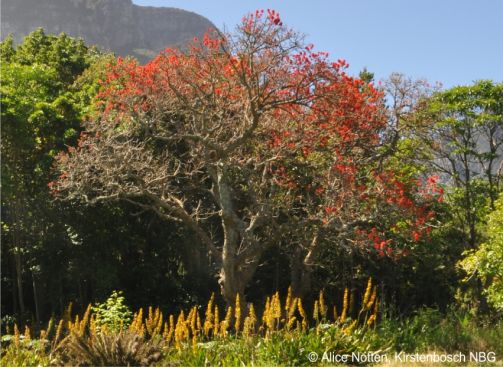
Description
Description
Erythrina abyssinica is a spectacular tree known for its bold appearance and vibrant flowers. It usually grows between 6 and 12 m tall and has a wide, spreading crown that provides plenty of shade. One of its most noticeable features is its rough, greyish-brown bark, which becomes deeply cracked as the tree ages. Many of its branches are covered in short, sharp spines, giving it a rugged look.
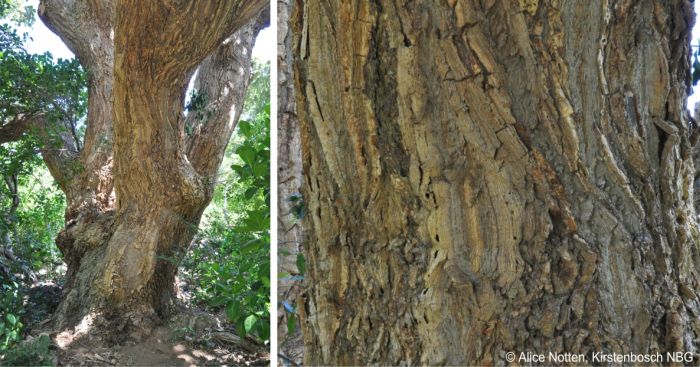
The leaves are bright green and made up of three leaflets, which are broad and slightly rounded. When young, they have a soft, fuzzy texture, but as they mature, they become smooth and glossy. They appear soon after the flowers, and their fresh green colour contrasts beautifully with the tree’s dramatic flowers.
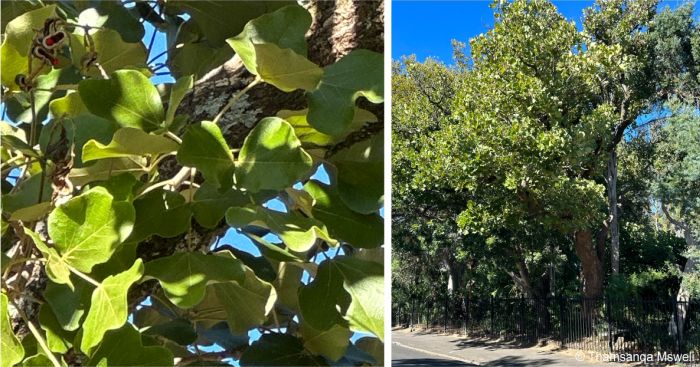
In late winter, spring and early summer (June to November), the tree produces spectacular red to orange flowers that grow in clusters at the tips of branches.
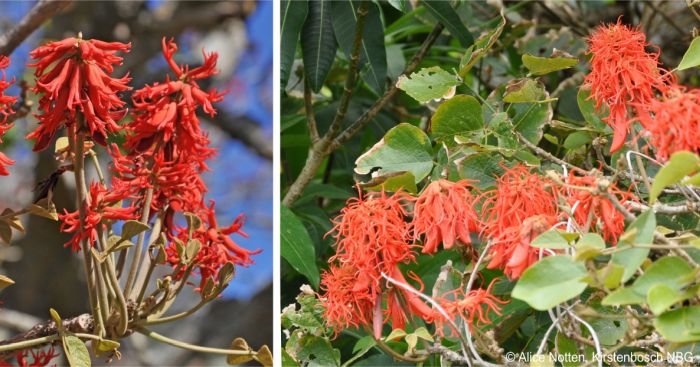
These flowers, similar in shape to pea flowers but with filamentous lobes on the calyx that gives them a fringed look, create a stunning display and attract birds and insects.
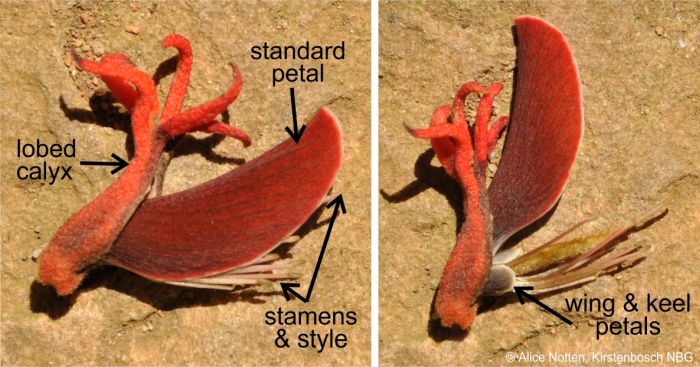
After flowering, the tree develops long, narrow seed pods that are about 100–200 mm long and strongly constricted between the seeds. At first, they are light brown and covered in soft hairs, but as they mature, they turn dark brown or black. Inside, they contain large, shiny seeds that are bright red or orange, adding even more visual appeal.
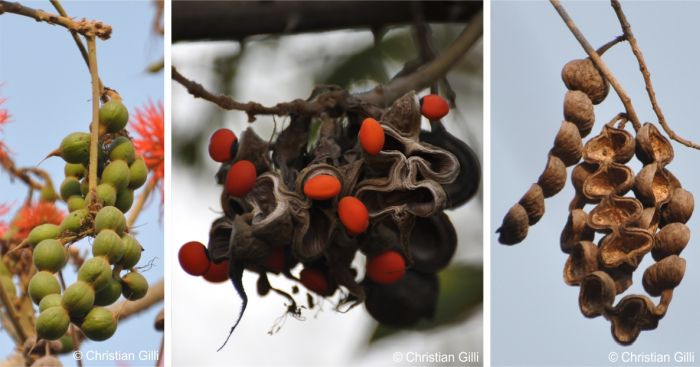
Erythrina abyssinica and Erythrina latissima are similar but can be distinguished by the standard flower petal of E. latissima being much larger (40–55 mm long) than those of E. abyssinica (30–35 mm long), and the terminal leaflet being larger, up to 300 × 320 mm, rounder and broader than that of E. abyssinica, which is up to 170 × 180 mm, egg-shaped and longer than it is broad.
Conservation Status
Status
As per the International Union for Conservation of Nature (IUCN) Red List, Erythrina abyssinica is assessed as Least Concern (LC). Its wide distribution and large wild population that is experiencing no major threats is the reason behind this.
Distribution and habitat
Distribution description
Erythrina abyssinica is native to east, central and southern Africa, in countries including Ethiopia, Kenya, Tanzania, Uganda and Sudan, thriving in mountainous regions near moist forests, forest edges, and riverbanks. This tree is also found in woodlands and grassy areas, where it stands out with its thick trunk and sturdy branches. It occurs as far south as Botswana, Zimbabwe and Mozambique, and is not indigenous to South Africa but may be found cultivated in certain areas for ornamental purposes, typically in botanical or private gardens. Preferring tropical to subtropical climates, it tolerates warm to hot temperatures and moderate to high rainfall, withstanding drought once established but not frost. Cultivation is suitable in tropical or subtropical regions with consistent warmth and limited frost exposure, requiring ample moisture during establishment but able to withstand some dry periods thereafter.
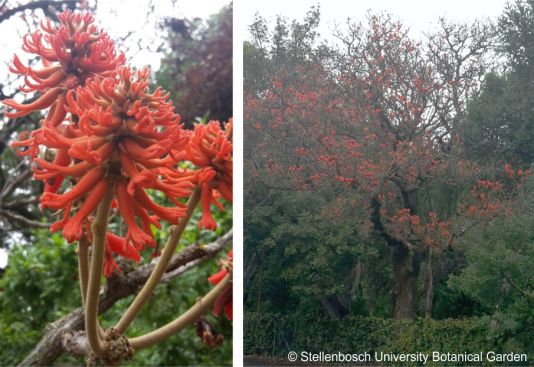
Derivation of name and historical aspects
History
The scientific name of Erythrina abyssinica derives from Greek and Latin roots. The genus name Erythrina originates from the Greek erythros meaning ‘red’, likely referring to its crimson flowers. The species name abyssinica signifies its origin in Abyssinia, now Ethiopia. Commonly known as the Abyssinian coral tree, it earned its name from both its Ethiopian roots and its vibrant coral-like blooms. Belonging to the Fabaceae, one of the largest families, with over 19 500 species, Erythrina abyssinica shares kinship with legumes significant for their ecological and economic roles. The genus Erythrina includes around 130 species globally. While the historical documentation of the discovery of Erythrina abyssinica remains vague, it likely captivated early botanical explorers in East Africa. It was named by Lamarck in 1786.
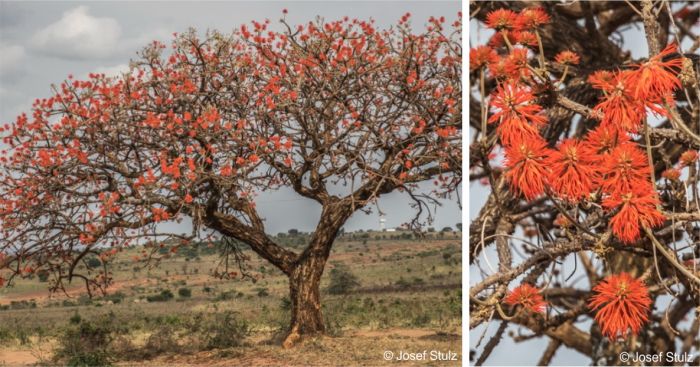
Ecology
Ecology
Erythrina abyssinica is a cornerstone of its ecosystem, providing food, shelter and ecological benefits. Its striking red-orange flowers bloom during the dry season, offering a crucial nectar source for sunbirds, bees and butterflies, when other food is scarce. The seeds are dispersed by birds and rodents, while their ability to float allows them to travel through streams and rivers, aiding natural regeneration. Erythrina abyssinica withstands drought by shedding its leaves to conserve water. Its thick, spiny branches deter herbivores, while deep roots access underground moisture. In fire-prone areas, the tree can resprout from its base, ensuring resilience and longevity. Beyond supporting pollinators, birds, and insects, this tree enriches the soil through nitrogen-fixing bacteria in its roots, benefiting surrounding vegetation. By fostering biodiversity and improving soil health, Erythrina abyssinica plays a vital role in sustaining its habitat.
Uses
Use
It provides shade, beauty, and a home for wildlife, making it both practical and ornamental. It is cultivated as an ornamental tree, often planted as a live fence due to its brightly coloured flowers and defensive prickles. The soft, greyish-white wood of Erythrina abyssinica exhibits a shot-silk effect. Although somewhat woolly to work with, it has been traditionally used to craft stools, toys, drums, pestles and fishing net floats. The seeds, often used to decorate trinkets, bracelets and necklaces sold as curios, contain toxic compounds that act similarly to curare, paralysing motor nerves. However, the poison is not easily absorbed through the skin, making handling generally safe. The tree’s stem and roots are harvested for timber and charcoal production, while its leaves serve as fodder for livestock. Additionally, the tree is a source of natural dye.
Beyond its aesthetic and craft applications, Erythrina abyssinica is a versatile and valuable plant with multiple practical and medicinal uses. The stem bark, roots, seeds, leaves and flowers, either individually or in combination, are widely used in herbal medicine to treat numerous ailments. However, the stem bark and roots are the most commonly utilised parts due to their high phytochemical concentration, making them a frequent focus in efficacy, toxicity and antimicrobial studies. Laboratory tests on extracts from these parts have confirmed the presence of antimicrobial compounds, supporting their medicinal applications. Traditional remedies derived from Erythrina abyssinica are prepared using diverse methods, including boiling (decoctions), cold infusions, drying and powdering, topical application and direct chewing. These remedies are used to treat a variety of ailments. Infectious diseases such as malaria, fevers, tuberculosis, bacterial and fungal infections, leprosy, pneumonia and HIV/AIDS are commonly treated with decoctions and cold infusions. Inflammatory conditions like arthritis, eye problems and general pain relief are managed using plant extracts, sometimes mixed with petroleum jelly for topical application. Metabolic disorders, including diabetes, anaemia and obesity, are also treated with decoctions. For skin and soft tissue infections, including wounds, scabies, herpes and ulcers, traditional practitioners often prepare herbal baths or topical pastes. Gastrointestinal issues, such as diarrhoea, stomach aches, constipation, dysentery and colic, are treated using decoctions, sometimes combined with honey or salt. Venereal diseases, including gonorrhoea, syphilis and urinary tract infections, and schistosomiasis, are also addressed with plant extracts. The plant is further used for reproductive health, aiding in infertility treatment, birth control and pregnancy-related conditions. Erythrina abyssinica is also valued as an antidote for poisoning and snake bites. In such cases, the sap is applied directly to the wound or consumed as a boiled extract. Neurological and central nervous system disorders, including epilepsy and convulsions, are treated by pounding the plant material, mixing it with salt, and consuming the preparation.
In livestock and poultry farming, extracts of Erythrina abyssinica are used to manage diseases such as Newcastle disease, anaplasmosis, and helminthosis. Its leaves also serve as a valuable fodder source for cattle and other livestock.
Growing Erythrina abyssinica
Grow
Erythrina abyssinica can be propagated through seeds, or cuttings. However, seed germination rates are relatively low, typically ranging from 10% to 30%. To improve germination success, seeds should be scarified (by nicking or scratching the outer coat and soaking in hot water before planting). Alternatively, propagation from truncheons is highly effective, with cuttings up to 3 m in length successfully rooting under suitable conditions. Take the cuttings in late winter to spring, just before the trees come out of dormancy. Allow the wound to dry for a day or two, plant in a well-drained medium such as 2 parts coarse sand mixed with 1 part milled pine bark, and keep moist in a warm, lightly shaded place.
This fast-growing species thrives in loamy to clay soils, preferring deep, well-drained substrates typically found on plateaus and slopes with a pH range of 3.5 to 5.5. Its deep root system enhances resilience against termites and fire, making it well adapted to its natural habitat. However, young trees are vulnerable to frost and should be protected until well established. Within three to four years, Erythrina abyssinica reaches a substantial size, and its aggressive root system requires careful site selection to prevent structural damage to nearby walls or paved areas.
Valued for its striking floral display, Erythrina abyssinica pairs beautifully with the white-flowering Dombeya rotundifolia, as both species bloom early in the season, creating a visually captivating contrast. Despite its ornamental appeal, the tree’s coarse-textured, straight-grained wood is prone to fungal attack. Additionally, its seeds, like those of Erythrina afra and possibly other species in the genus, contain a curare-like toxin. If introduced directly into the bloodstream, this toxin can induce anaesthesia, paralysis, and even death due to respiratory failure. However, there is no known risk associated with handling.
References
- Beentje, H.J. 1994. Kenya trees, shrubs and lianas. National Museums of Kenya, Nairobi.
- Botanic Gardens Conservation International (BGCI) & IUCN SSC Global Tree Specialist Group. 2019. Erythrina abyssinica. The IUCN Red List of Threatened Species. Online. https://www.iucnredlist.org/species/146210922/146210924.
- Coates Palgrave, K. 2002. Trees of southern Africa. Struik, Cape Town.
- Gilli, C. 2011. Observation of Erythrina abyssinica, Jimma, Ethiopia. iNaturalist. Online. https://www.inaturalist.org/observations/194296026.
- Obakiro, S., Kiprop, A., Odero, M. & Omara, T. 2021. Traditional medicinal uses, phytoconstituents, bioactivities and toxicities of Erythrina abyssinica Lam. (Fabaceae): a aystematic review. Evidence-Based Complementary and Alternative Medicine 5513484.
- Orwa, C., Mutua, A., Kindt, R., Jamnadass, R. & Anthony, S. 2009. Erythrina abyssinica. Agroforestree Database: a tree reference and selection guide version 4.0. https://apps.worldagroforestry.org/treedb/AFTPDFS/Erythrina_abyssinica.PDF.
- Plants of the World Online. Erythrina abyssinica Lam. https://powo.science.kew.org/taxon/urn:lsid:ipni.org:names:494336-1. Accessed 11 Mar. 2025.
- Stellenbosch University Botanical Garden, Garden Explorer. Erythrina abyssinica. https://sun.gardenexplorer.org/taxon-1158.aspx. Accessed 8 February 2025.
- Stulz, J. 2020. Observation of Erythrina abyssinica, Kaabong, Uganda. iNaturalist. Online. https://www.inaturalist.org/observations/69714618.
- Voigt, W. 2006. Erythrina afra Thunb. (Fabaceae). PlantZAfrica. Online. https://pza.sanbi.org/erythrina-afra.
- Wikipedia. Erythrina abyssinica. https://en.wikipedia.org/wiki/Erythrina_abyssinica. Accessed 8 Feb. 2025.
Credits
Thamsanqa Msweli
KwaZulu-Natal National Botanical Garden
March 2024
Acknowledgements: the author thanks the Stellenbosch University Botanical Garden, Alice Notten, Christian Gilli and Josef Stulz for allowing the use of their images.
Plant Attributes:
Plant Type: Tree
SA Distribution:
Soil type: Sandy, Loam
Flowering season: Spring, Early Summer, Winter
PH:
Flower colour: Red
Aspect: Full Sun, Morning Sun (Semi Shade), Afternoon Sun (Semi Shade)
Gardening skill: Easy
Special Features:
Horticultural zones
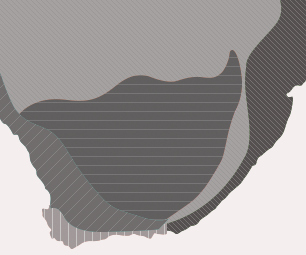








Rate this article
Article well written and informative
Rate this plant
Is this an interesting plant?
Login to add your Comment
Back to topNot registered yet? Click here to register.